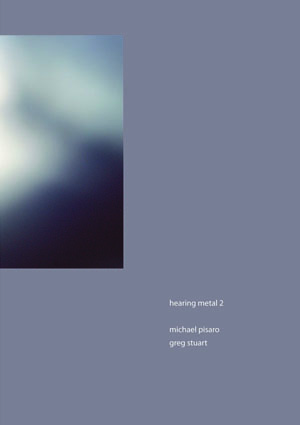Michael Pisaro, "Hearing Metal 2 (Le table du silence)"
 It may be that hearing metal means something different than hearing music. Like the Constantin Brâncuși sculpture to which its subtitle refers, Michael Pisaro's Hearing Metal 2 subsists more in the grain and shape of its materials and less in the will of its author. It is composed and performed, and has a beginning and an ending, but it doesn't move from left to right like a song. It feels and sounds more like a space that I can walk through, my position and my frame of mind determining how—and what—I hear.
It may be that hearing metal means something different than hearing music. Like the Constantin Brâncuși sculpture to which its subtitle refers, Michael Pisaro's Hearing Metal 2 subsists more in the grain and shape of its materials and less in the will of its author. It is composed and performed, and has a beginning and an ending, but it doesn't move from left to right like a song. It feels and sounds more like a space that I can walk through, my position and my frame of mind determining how—and what—I hear.
Inspired by Greg Stuart's close recordings of the 60" tam-tam used in Karlheinz Stockhausen's Mikrophonie I, Michael Pisaro's Hearing Metal series began as project dedicated to hearing the inner life of apparently uniform sounds. The association with Brâncuși sculptures came when he realized that the physical material of his chosen instruments expressed particular qualities or affects on their own—as if a sense of the material were coming through the music. As he explains on his blog, "Any sound, even the simplest, is already (ontologically) multiple. But the multiplicity requires a succession of events to be heard: by extending, repeating, adding and subtracting, one begins to experience the sound more like a verb than like a noun."
I think of that last claim every time I listen to Hearing Metal 2. On the one hand, Pisaro and Stuart's assortment of cymbals, gongs, brake drums, and various metal objects resound together like a single instrument. Listening is like watching a metal sculpture rotate in place. If I sit in one spot and watch it spin, different aspects of its form slide into view and fall away like a slideshow. But if I get up and investigate, peer at it closely, or fix my attention on one of its sides, new qualities pop out. They were always there, but finding them depends on interacting with the piece and not just letting it slide by the way songs typically do. Thanks to the way Pisaro has arranged his sounds, this sculptural feeling is sustained throughout the piece's long, central metallic passage. There are no crescendos or obvious dynamic markers—just the varying qualities of different textures playing against the hum of a central, pitched core. There are quieter and noisier moments, but they don't add up to something bigger and tip the composer's hand.
On the other hand, Hearing Metal 2 unfolds in time and needs time to make sense. The music doesn't resound all at once, and I can't actually walk around it the way I would a sculpture, so I have to listen to what it does. That's when the metal instrumentation begins to express something like an inner life: little networks of rhythm spill out of the otherwise chaotic jumble of junkyard sounds and apparently fixed tones wobble back and forth like they're walking on a tightrope; odd sounds are cast to the periphery and others are pushed to the center as the metal rolls and twists in circles, something Pisaro's stereo mix captures extremely well. But all this happens of its own accord, seemingly without Michael or Greg's influence. The music stops progressing from beginning to end and starts acting, stretching out in different directions, and evolving. The illusion Pisaro and Stuart create is that they had nothing to do with it. The sound was there the whole time, all they did was capture it.
Framing the 40-plus minute core of Hearing Metal 2 are two blocks of field recordings and other seemingly non-metallic sounds. The longer, first section captures oceans and rivers tossing and bubbling in undisclosed locations. Strange, almost psychedelic test tones beam in from outer space. A church organ hums. Sine waves peak out of the silence and succumb to the movement of a stream down a muddy bank. The humming metal doesn't start until over 16 mintes in, and by then it feels as if we've been guided down a waterway just to see this huge edifice Pisaro's built. When it ends, we're brought back to the sounds of running water and chirping birds. It's a reminder that hidden sounds are all around us, and that how we listen is as important as what we hear.
samples:
 



